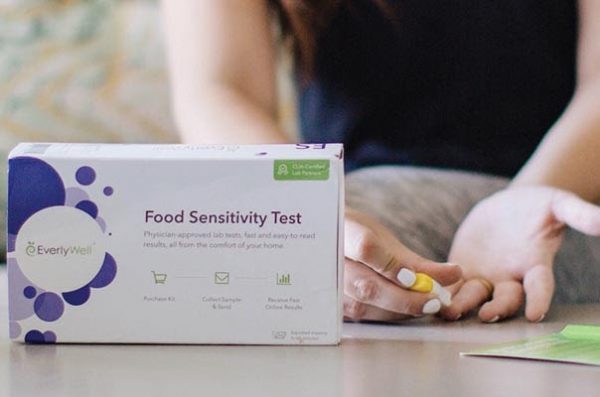That’s the subject of the article Caitlin Dow published in May 2019 in Nutrition
Action – ‘unbiased advice to help you eat healthfully and live longer ‘.
You might be familiar with the Nutrition Action newsletter
(https://www.nutritionaction.com) as it has a following of 2 million people. It is
produced by the Center for Science in the Public Interest (CSPI), a nonprofit
organization.

Key with these at-home tests is measuring your body’s IgG response to Food. IgG
stands for Immunoglobulin G, a protein that’s a defender against bacteria and
viruses and the most common type of antibody found in your blood circulation.
Check your local Wikipedia if you are eager to learn about antibodies, IgG, IgE, IgA,
IgM; if healthfully is a real word, or why your blood is read. Anyhow, the tone of
the article on testing with IgG is ‘not so fast’.
“IgG has never been validated as a test for diagnosing food intolerance,”
says Christina Ciaccio, an award-winning physician and interim chief of allergy and
immunology at the University of Chicago Medical Center. Dr. Ciaccio is passionate
about understanding how nutrition (prebiotics) and microbial exposures (probiotics)
affect sensitization. She explains: ’High levels of IgG may simply mean that you
were exposed to a food. In fact, some research suggests that high IgG may mean
that you can eat the food with no harm.”
“When patients bring in IgG test results, I quiz them about what they eat a lot of,
and it’s often exactly what the test says they’re intolerant to, even though they’ve
never had a reaction to those foods,” says Ciaccio. “Just because your immune
system recognizes a food doesn’t mean that you’re reacting to it.”
u

Globally, the cuisines change, eating different than/then 15 years ago; other
ingredients from ‘a far’. The food scenes in NYC, Amsterdam and Shanghai
nowadays are way more diverse, and attractive! But the response of our bodies can
be challenged with all the new stuff and styles and we don’t always know what we
are eating. So the question is:
What’s the difference between a food allergy and food intolerance?
In 2017 Mayo Clinic ‘s Prof. dr. James Li, a leading authority on allergy, addressed
this question: “Physical reactions to certain foods are common, but most are caused
by a food intolerance rather than a food allergy. Food intolerance can cause some
of the same signs and symptoms as a food allergy, so people often confuse the two.
A true food allergy causes an immune system reaction that affects
numerous organs in the body. It can cause a range of symptoms. In some
cases, an allergic food reaction can be severe or life-threatening. In contrast, food
intolerance symptoms are generally less serious and often limited to
digestive problems.
If you have a food intolerance, you may be able to eat small amounts of the
offending food without trouble. You may also be able to prevent a reaction. Causes
of food intolerance include:
* Absence of an enzyme needed to fully digest a food. Lactose intolerance is a
common example.
* Irritable bowel syndrome. This chronic condition can cause cramping,
constipation and diarrhea.
* Sensitivity to food additives. For example, sulfites used to preserve dried fruit,
canned goods and wine can trigger asthma attacks in sensitive people.
* Recurring stress or psychological factors. Sometimes the mere thought of a
food may make you sick. The reason is not fully understood.
* Celiac disease. Celiac “gluten” disease has some features of a true food allergy
because it involves the immune system. However, symptoms are mostly
gastrointestinal, and people with celiac disease are not at risk of anaphylaxis. at
and other grains.
·
If you have a reaction after eating a particular food, see your doctor to determine
whether you have a food intolerance or a food allergy. If you have a food allergy,
you may be at risk of a life-threatening allergic reaction (anaphylaxis) — even if
past reactions have been mild. Learn how to recognize a severe allergic reaction
and know what to do if one occurs. If you have a food intolerance, your doctor
may recommend steps to aid digestion of certain foods or to treat the underlying
condition causing your reaction.”
Prof. Dr. James Li is chair of the Division of Allergic Diseases in the Department of
Internal Medicine, Mayo Clinic. (https://www.mayoclinic.org)
Dr. Ciaccio’ s classification: “I dump any adverse reaction to food that isn’t due to
an immune response into the food intolerance category.”
“Some intolerances, like to lactose (a sugar in milk), can cause gastrointestinal
distress. Sulfites in dried fruit and wine can cause life-threatening asthma-like
symptoms. Histamine intolerance—linked to some fish and fermented or cured
foods like cheese and wine—may lead to nausea, headaches, or flushing. In theory,
any food could trigger an adverse reaction.”
Culinary Argan oil is safe, no known allergies, no nut-allergies as the kernel is a
stone-fruit, just like apricot. The FDA considers argan as ‘GRAS’: Generally
Recognized As Safe. Did you know 90% of allergic reactions are caused by
only 8 foods? These foods are eggs, fish, milk, peanuts, shellfish, soybeans, tree
nuts, and wheat.
So an at-home test may help identify, but be cautious as these tests have not been
accredited yet. There’s no easy or reliable way to diagnose food intolerances,
although. Dietitians, in particular, can be helpful in identifying ‘problem foods’ and
prevent trouble. Anyhow, “There’s no blood or skin test we can do,” says Ciaccio. “
Your best bet is to try an elimination diet. Cut out all suspect foods for a couple of
weeks, then re-introduce them one by one.”
On a site note: it was quite a surprise to see how small the ‘regular, dietitian-approved’ doses of food are. Registered dieticians have a sample set of plastic food
staples to illustrate your food intake, but yuck, most of these are visual terrifying.
CNN airs a ‘chasing life’ series by Dr. Sanjay Gupta, where he searches for the key
to living better. In Japan’s Okinawa, home of the centennials, ‘hara hachi bu’ is
the philosophy. It means: stop eating when you are 80% full. So stay a little
hungry. Sorry, don’t know the words for ‘doggy bag’ in Japanese. On the other
hand, my mother had a ‘clean your plate’ philosophy, No leftovers allowed.
Picture empty plate

